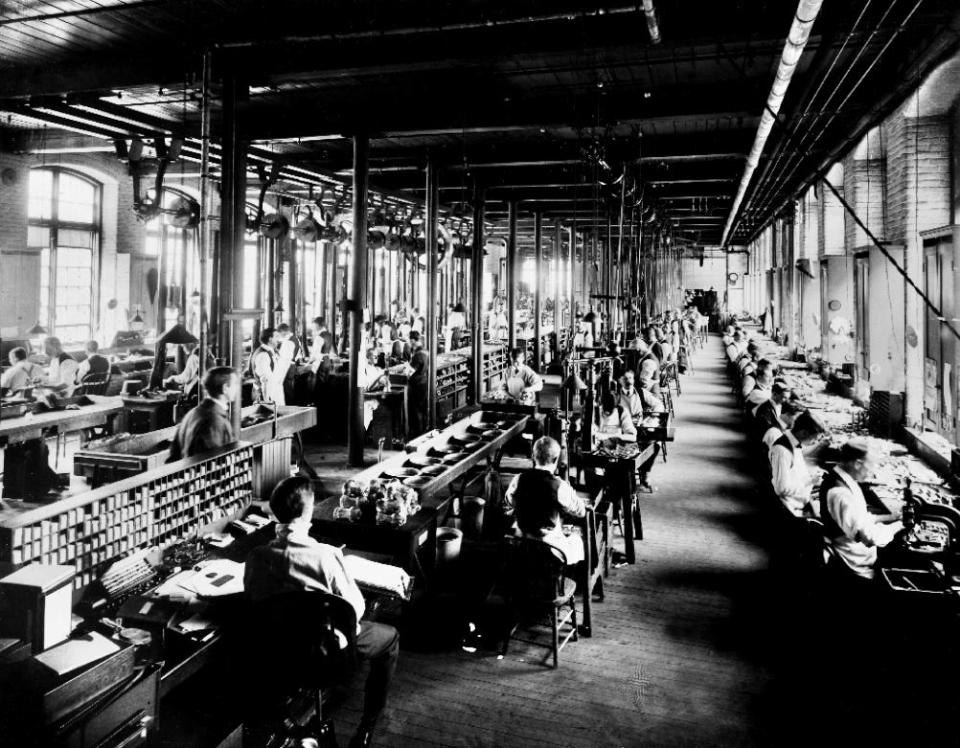Mills say a lot about RI’s manufacturing achievement | Opinion
- Oops!Something went wrong.Please try again later.
Patrick T. Conley is historian laureate of Rhode Island and a real estate developer.
Congratulations to filmmaker David Lawlor for his effort to preserve Rhode Island’s industrial heritage with his visual history of our mills, especially those now abandoned, and to reporter Antonia Noori Farzan for her coverage of this endeavor ("Before they're gone," News, Oct. 14).
The mill buildings that dot our rural landscape and dominate sections of our cities are more than mere brick and mortar; they are reminders of who we were and who we have become.
Our mills are monuments to Rhode Island ingenuity – to technological giants like Samuel and John Slater, David Wilkinson, Thomas Poynton Ives, Nicholas Brown II, Zachariah Allen, Jabez Gorham, Lucian Sharpe, William Nicholson, George Corliss, and Joseph Banigan, to name a few – and to Rhode Island’s preeminence as America’s first urban-industrial state. These distinctions should be a source of local pride.
More: Interior secretary visits Old Slater Mill to highlight creation of national historical park
America’s current position of world leadership, its technological superiority, and its lofty standard of living are due, in part, to the transformation of its economy in the late 19th century from an agricultural to an industrial base. Therefore, those who spearheaded that transition merit remembrance. Rhode Island’s surviving mills are silent reminders of their contribution to America’s achievement.
Whereas the entrepreneurs merit monuments, all those who engage in worthy endeavor deserve appreciation and remembrance. The successive waves of immigrants who manned (and womaned) Rhode Island’s mills should not have toiled in perpetual obscurity; the mills are also their memorial.

Woonsocket’s Museum of Work and Culture, appropriately housed in a recycled mill, is a giant step in the right direction, but one facility does not exert the impact on our memory and imagination as a landscape and streetscape containing well-preserved, refurbished factories of architectural merit and historical significance.
The mill meant employment to the immigrant generation. Here the newcomers established their contact with America. Here their unremitting labor financed the education of their children and launched their families on an upward journey into the middle class and beyond. The mill experience in Rhode Island was an ethnic anvil chorus.
Radical historians have railed against the mill owners, charging them with exploitation of the masses. Such an unbalanced view exalts ideological rhetoric over historical reality. The rich are often seen through the green eyes of envy. Mill owners were human beings, just like police, politicians, doctors, and priests. Some were benevolent and socially concerned; others were ruthless and self-absorbed.
By 1900 economically diverse Providence ranked among the nation’s 10 biggest industrial centers, and its Board of Trade boasted that the city contained the world’s largest tool factory (Brown & Sharpe), file factory (Nicholson File), engine factory (Corliss Steam Engine Company), screw factory (American Screw), and silverware factory (Gorham). These were exuberantly proclaimed as Providence’s Five Industrial Wonders of the World. In addition, the city ranked first nationally in the manufacture of jewelry and the production of woolen and worsted goods, and third (behind Philadelphia and Cincinnati) in production of base metals. It also contained the home offices of the famed Knight brothers’ cotton textile empire.
The titans and the toilers combined to make Rhode Island first nationally in per capita wealth and a leader of America’s Industrial Revolution. Our mill buildings are their monument and memorial; they are the structures that best typify our state’s history.
More: What's next for Cranston Print Works? Inside the developer's proposal
Thus far, I have written as a sentimental historian emphasizing heritage and aesthetics. However, abandoned mills also activated my practical and legal instincts as a real estate developer. Many of these abandoned structures have gone up for tax sale over recent decades, and my wife Gail and I have successfully bid to acquire a dozen of them.
After clearing title, we either renovated these mills or sold them to large developers who would undertake that task. Our favorite and most notable project was the purifying plant of the Gas Company on the Allens Avenue waterfront which we renamed Conley’s Wharf and placed on the National Register of Historic Buildings after a $7.1-million rehabilitation. Sadly, it now sits vacant because of the city’s refusal to rezone this waterfront from marine-industrial to mixed use.
Whether for memory or for money, for heritage or housing, our mills deserve to be preserved.
This article originally appeared on The Providence Journal: RI's mill buildings are more than mere brick and mortar; they are reminders of who we were and who we have become.

